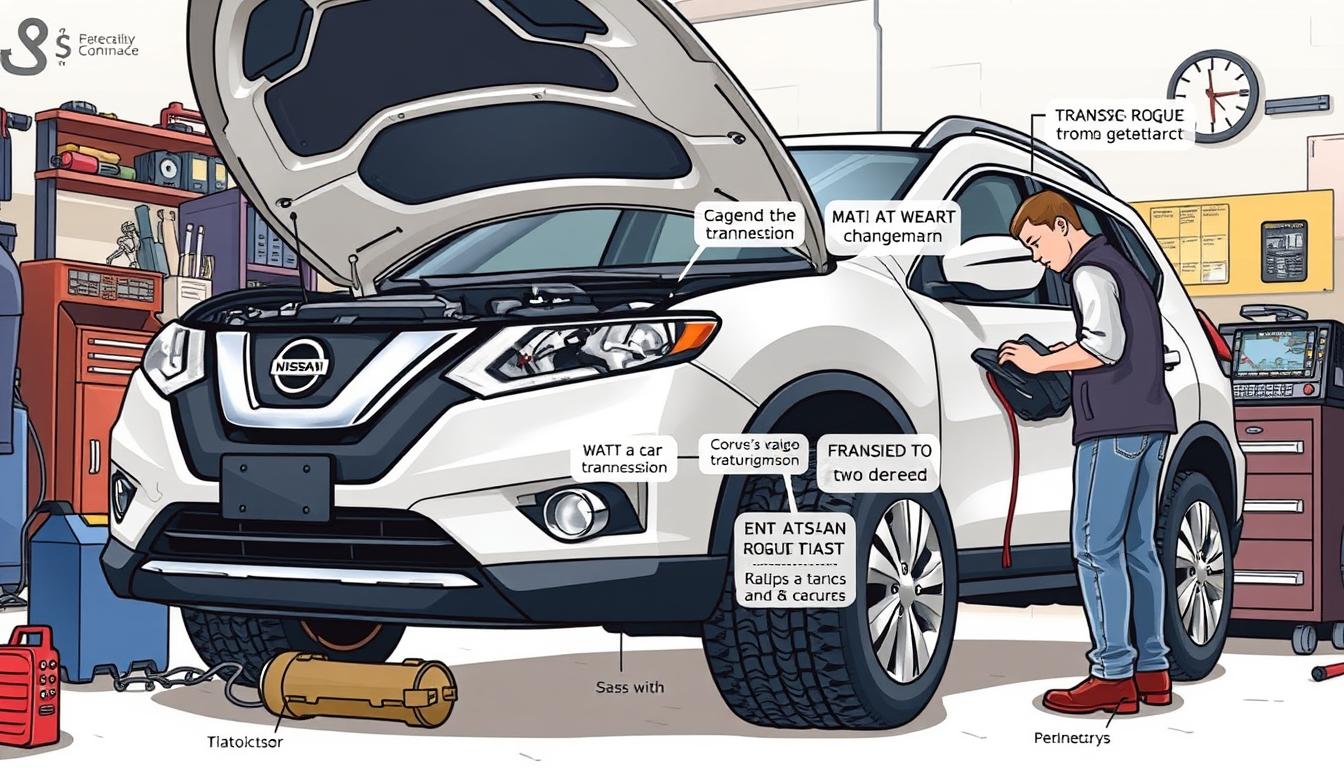Nissan Rogue owners often face issues like shuddering, stalling, and transmission failure. A class-action lawsuit highlighted these problems. The CVT system, used in models from 2008 to 2016, is often at fault.
Transmission overheating can start around 100,000 miles. This is due to hot weather, towing heavy loads, or stop-and-go traffic. Keeping the CVT transmission fluid well-maintained is key to avoiding these problems. A lawsuit settlement of $277.7 million shows how serious these issues are.
It’s important to understand the causes and symptoms of these problems. This knowledge helps in troubleshooting and keeping the transmission system healthy. Nissan has extended the warranty for CVT transmissions to 10 years or 120,000 miles. But, it’s vital to stay proactive in preventing these issues.
Key Takeaways
- Nissan Rogue models from 2008 to 2016 are prone to transmission issues, mainly with the CVT system.
- Regular maintenance of the CVT transmission fluid is advised every 30,000 miles to avoid common problems.
- Transmission overheating can happen due to hot weather, towing heavy loads, or stop-and-go traffic.
- The Nissan Rogue transmission problem has led to a lawsuit settlement of $277.7 million.
- The warranty for Nissan CVT transmissions has been extended to 10 years or 120,000 miles.
- Knowing the causes and symptoms of transmission issues is crucial for troubleshooting and maintenance.
Understanding Nissan Rogue Transmission Systems
The Nissan Rogue comes with a Continuously Variable Transmission (CVT). It’s made to give smooth starts and better fuel use by skipping the usual gear shifts. But, Nissan Rogue CVT transmission problems have been a big worry, mainly for models made from 2008 to 2016.
CVT Transmission Basics
A CVT doesn’t have fixed gears, so it can change ratios endlessly. This makes driving smooth and can save fuel. Yet, the CVT in the Nissan Rogue often faces issues like shuddering, slipping, and even failing completely. This has caused big Nissan Rogue transmission issues.
Different Model Year Specifications
Over the years, the Nissan Rogue’s transmission has changed a lot. Models from 2008 to 2016 had more CVT problems. There were many reports of the transmission getting too hot and breaking down. Nissan then updated later models to fix these issues.
Common Components and Their Functions
The Nissan Rogue’s transmission system has a few key parts:
- CVT Belt: It moves power from the engine to the wheels, changing the gear ratio as needed.
- Transmission Fluid: It keeps the moving parts from getting too hot and wearing out.
- Torque Converter: It helps the engine power reach the transmission, so the car can stop smoothly.
Knowing about these parts helps figure out and fix Nissan Rogue CVT transmission problems.
| Model Year | Reported Transmission Complaints |
|---|---|
| 2008 | 15 |
| 2016 | 20 |
| 2018 | 30 |
| 2019 | 13 |
| 2021 | 13 |
| 2023 | 13 |
Recognizing Early Warning Signs of Transmission Issues

Spotting transmission problems early can prevent expensive fixes for Nissan Rogue owners. Signs include hesitation or stalling when you try to speed up. Also, feeling the car slip or jerk while driving is common.
Another key sign is overheating. If the transmission gets too hot, it can cause serious damage. Unusual sounds like whining, grinding, or humming when shifting gears also point to problems inside the transmission.
- Hesitation or Stalling: Delayed response when accelerating.
- Slipping or Jerking: Unexpected changes in speed without engine changes.
- Overheating: High transmission temperatures affecting performance.
- Unusual Noises: Grinding or whining sounds during operation.
Fluid leaks are a big warning sign. Low fluid can cause slipping and overheating. A burning smell means the fluid is too hot. Never ignore dashboard warning lights, like the transmission light, as they signal serious issues.
| Symptom | Possible Cause |
|---|---|
| Hesitation or Stalling | Delayed gear shifting or low transmission fluid |
| Slipping or Jerking | Worn transmission bands or belt issues |
| Overheating | Low fluid levels or heavy towing |
| Unusual Noises | Internal transmission damage or misalignment |
Common Nissan Rogue Transmission Problems and Their Symptoms
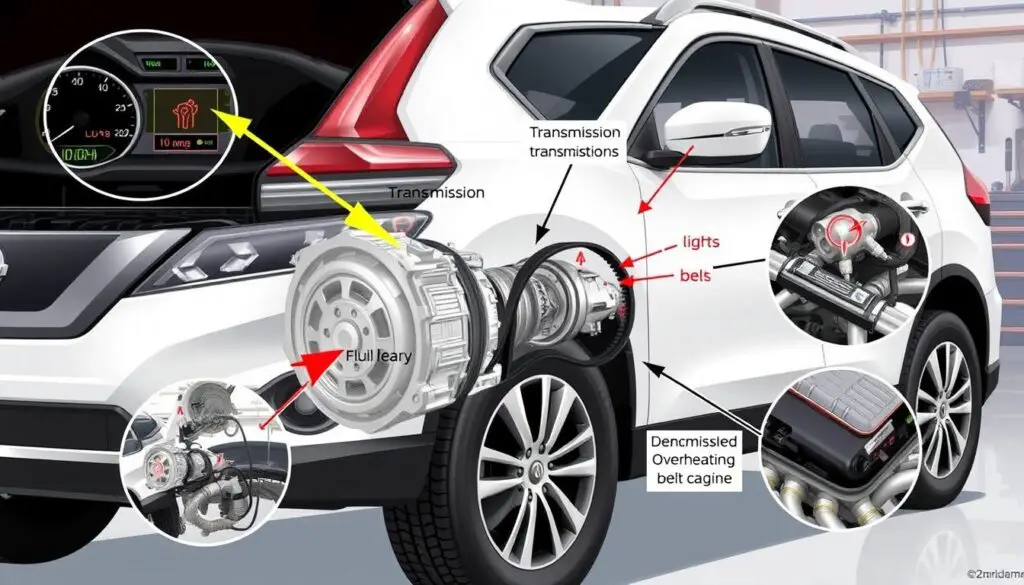
Nissan Rogue owners often face common Nissan Rogue transmission problems. These issues can harm the car’s performance and lifespan. Spotting these problems early can avoid big failures and expensive fixes.
CVT Belt Issues
CVT belt and pulley problems are common in Rogues from 2008 to 2016. These issues can cause uneven power and jerky acceleration. This makes driving uncomfortable.
Transmission Fluid Leaks
Fluid leaks from the transmission are a big worry. They’re often seen as blue CVT fluid. Leaks can damage seals or parts, leading to less lubrication and more friction. This can cause Nissan Rogue transmission failure.
Shifting Delays
Shifting delays can signal transmission problems. Owners might notice slow or no gear changes. This can affect vehicle control and safety.
Overheating Problems
Transmission overheating starts around 100,000 miles, often when towing or in stop-and-go traffic. Overheating speeds up wear on parts. This can lead to total failure.
| Problem | Symptoms | Potential Consequences |
|---|---|---|
| CVT Belt Issues | Jerky acceleration, uneven power | Transmission failure, expensive repairs |
| Transmission Fluid Leaks | Blue fluid spots, low fluid levels | Increased friction, overheating |
| Shifting Delays | Sluggish gear changes, delayed response | Compromised vehicle control, safety risks |
| Overheating Problems | High transmission temperature, warning lights | Accelerated wear, complete transmission failure |
Diagnostic Steps for Transmission Problems

Spotting transmission issues early can save you from expensive fixes. First, make sure your Nissan Rogue has the right amount of transmission fluid. Low fluid can lead to shifting troubles and overheating.
- Check the transmission fluid level and condition.
- Inspect for any visible leaks under the vehicle.
- Listen for unusual noises during operation.
If simple checks don’t find the problem, professional diagnosis is a good next step. Skilled mechanics use special tools to find the exact issue. They can read error codes from your car’s computer, which is key for fixing problems.
- Error Code Interpretation: Mechanics use scanners to read error codes, giving clues about specific transmission faults.
- Road Tests: Driving the car under controlled conditions helps spot issues like slow shifting or odd vibrations.
- Thorough Inspections: Visual and mechanical checks can find problems like worn belts or leaks.
Knowing these steps helps you talk better with your mechanic. This ensures your Nissan Rogue transmission repair is done right and fast.
| Diagnostic Tool | Purpose |
|---|---|
| OBD-II Scanner | Reads error codes from the vehicle’s computer |
| Transmission Fluid Tester | Checks the condition and level of transmission fluid |
| Road Test Equipment | Monitors vehicle performance during driving |
The Role of Transmission Fluid in Performance
Transmission fluid is key to your Nissan Rogue’s smooth running. It lubricates parts and keeps the transmission cool. This prevents overheating and wear.
Proper Fluid Levels
It’s crucial to keep the right amount of transmission fluid. Low fluid can cause shifting problems and overheating. Always check the fluid with the dipstick and make sure it’s at the right level. This helps avoid Nissan Rogue transmission issues.
Fluid Change Intervals
Nissan suggests changing CVT transmission fluid every 60,000 miles. But for the Rogue, it’s better to do it every 30,000 miles. This helps fix fixes for Nissan Rogue transmission issues and extends the transmission’s life.
Signs of Contaminated Fluid
Dirty transmission fluid can harm your car. Look for dark, smelly fluid, which means it’s breaking down. Also, watch for odd noises and shifting issues. Fixing these problems quickly with the right fluid can stop Nissan Rogue transmission issues.
| Driving Conditions | Recommended Fluid Change Interval |
|---|---|
| Normal | Every 60,000 miles |
| Severe (e.g., towing, heavy traffic) | Every 30,000 miles |
| Extreme (e.g., very hot climates) | Every 30,000 miles |
CVT Transmission Maintenance Tips

Keeping your Nissan Rogue’s CVT transmission in good shape is key. Regular care helps avoid common problems and keeps your car running smoothly.
Here are some key maintenance tips:
- Check the transmission fluid level every 30,000 miles to ensure it’s within the recommended range.
- Replace the CVT fluid every 60,000 miles, or sooner if you frequently drive in heavy traffic or tow loads.
- Avoid aggressive acceleration and sudden stops to reduce transmission strain.
- Ensure timely service appointments to address minor issues before they escalate.
Following Nissan’s service schedule is important. Skipping regular checks can cause overheating, which may need expensive Nissan Rogue transmission repair. By sticking to these fixes for Nissan Rogue transmission issues, you can make your CVT last longer.
| Maintenance Task | Recommended Interval | Action |
|---|---|---|
| Transmission Fluid Check | Every 30,000 miles | Ensure fluid level is adequate |
| Transmission Fluid Replacement | Every 60,000 miles | Replace with Nissan-approved fluid |
| Inspection for Leaks | Every service interval | Check and repair any fluid leaks |
| Software Updates | As recommended by Nissan | Update transmission control software |
When to Visit a Professional Mechanic
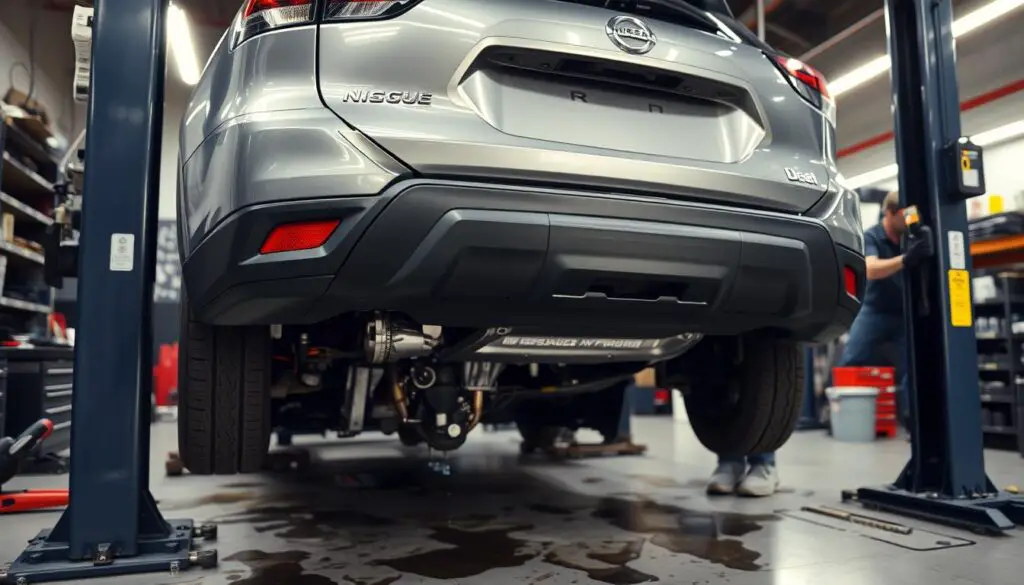
If your Nissan Rogue is giving you trouble, it’s important to know when to get help. Quick action can stop small issues from becoming big ones.
Emergency Symptoms
- Complete loss of power while driving
- Severe shuddering or vibrations
- Unusual noises like grinding or whining
- Transmission fluid leaks
Routine Check Requirements
Getting your Nissan Rogue checked regularly is key. It helps catch problems early, saving you money later. Make sure the transmission fluid is at the right level and clean.
Finding Qualified Repair Shops
- Look for mechanics specializing in Nissan CVTs
- Check certifications and customer reviews
- Ask about warranties on repairs
- Ensure they have the necessary diagnostic tools
| Model Year | Transmission Issues | Recommended Action |
|---|---|---|
| 2008-2013 | High incidence of transmission failures and fluid leaks | Avoid purchasing used models from these years |
| 2014-2016, 2018 | Fewer reported transmission problems | Recommended safer years for used Nissan Rogues |
Estimated Repair Costs and Warranty Coverage

Knowing the costs of Nissan Rogue transmission repair is key for owners with Nissan Rogue transmission failure. The price to fix or replace the CVT transmission can change a lot. This depends on how bad the problem is.
Part Replacement Costs
Replacing parts for a Nissan Rogue’s transmission can cost between $3,000 and $5,000. This price includes the parts needed to make the transmission work right again.
Labor Expenses
Adding to the cost, labor for Nissan Rogue transmission repair can be $500 to $1,500. This is because skilled workers are needed to install the transmission correctly.
Extended Warranty Options
Nissan has extended warranties for some models. These cover repairs, replacements, and towing for transmission issues. It’s vital to check which years are covered and what services are included.
Getting an extended warranty can give you peace of mind. It might also lower what you have to pay if your Nissan Rogue transmission fails.
Prevention Strategies for Long-Term Transmission Health
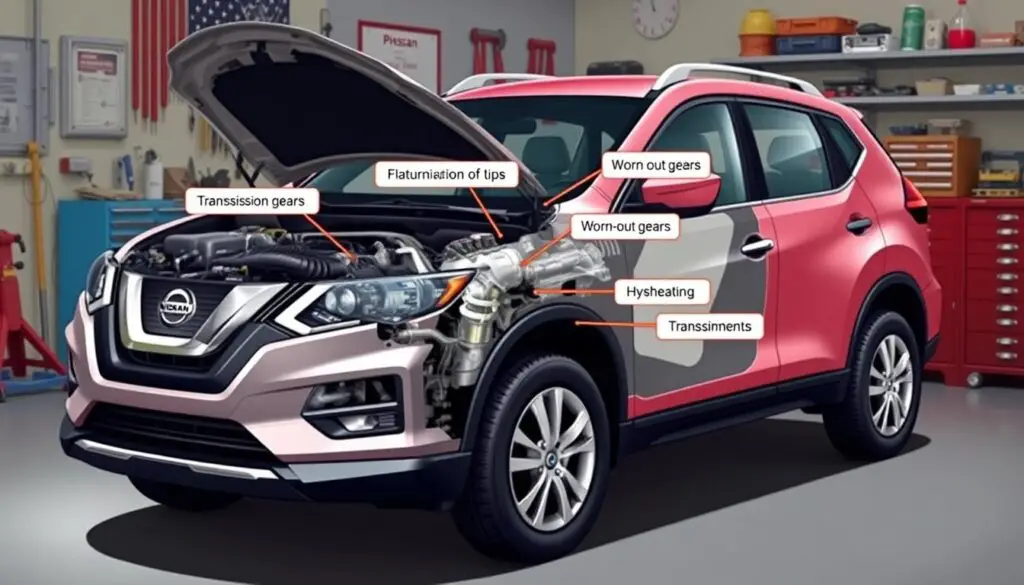
Keeping your Nissan Rogue’s transmission healthy is key for its long life and good performance. By tackling common Nissan Rogue transmission problems early, you can dodge expensive fixes later.
- Regular Maintenance: Stick to the maker’s schedule for fluid checks and changes. This catches early signs of fixes for Nissan Rogue transmission issues.
- Smooth Driving Habits: Don’t speed up too fast or tow heavy loads. Driving smoothly puts less stress on the transmission. This lowers the chance of shifting delays and overheating.
- Cooling System Care: Make sure the cooling system works right. A good cooling system stops the transmission from getting too hot, a big common Nissan Rogue transmission problem.
Also, keeping other parts like the engine and brakes in shape helps the transmission work better. Regular checks can spot problems early. This leads to quick and effective fixes for Nissan Rogue transmission issues.
Impact of Driving Habits on Transmission Longevity
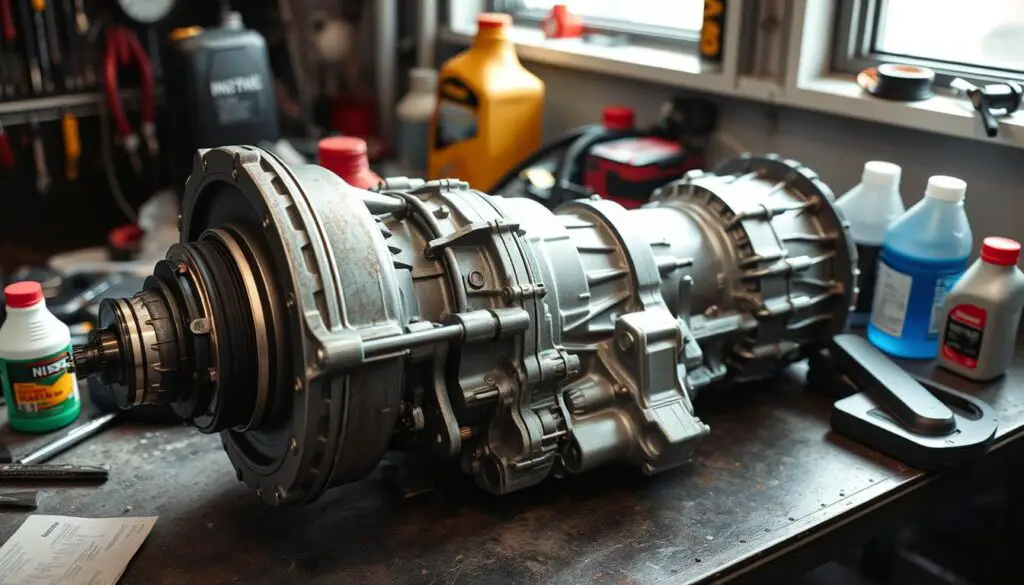
How you drive affects your Nissan Rogue’s transmission life. Using the right driving techniques can help avoid common issues. This way, you can keep your transmission running smoothly.
Best Practices
- Gradual Acceleration: Start slowly to ease the strain on your transmission.
- Maintain Steady Speeds: Drive at a steady pace on highways to reduce wear.
- Regular Maintenance: Change the CVT transmission fluid every 30,000 miles to prevent problems.
- Avoid Overloading: Don’t carry more weight than your vehicle can handle.
Habits to Avoid
- Aggressive Driving: Fast starts and high speeds can cause the transmission to overheat.
- Frequent Hard Braking: Frequent stops and starts put extra stress on the transmission.
- Heavy Towing: Towing too much can make transmission problems worse.
- Ignoring Warning Lights: Don’t ignore dashboard alerts. They can prevent serious damage to your transmission.
By driving well and avoiding bad habits, you can make your Nissan Rogue’s transmission last longer. This helps solve common problems and keeps your vehicle running smoothly.
Understanding Technical Service Bulletins and Recalls
Nissan often releases Technical Service Bulletins (TSBs) to help fix issues. This includes common problems with the Nissan Rogue’s transmission. Unlike recalls, TSBs deal with non-safety issues found by the maker.
Historical Recalls
Nissan has recalled the Rogue to fix specific transmission issues over time. For instance, Service Bulletin NTB12057 fixed a problem where the car went into fail-safe mode due to high CVT fluid temperatures. These steps helped solve common transmission problems and made the car run smoother.
Current Safety Notices
Today, Nissan keeps an eye on the transmission’s performance. They’ve issued safety notices about possible communication problems in the transmission system. It’s important for owners to keep up with these updates to quickly fix any new transmission issues.
Keeping up with TSBs and recalls is key to keeping your car safe and running well. You can find this info on the Nissan Techinfo website or by talking to a Nissan dealership. This way, you can make sure any transmission problems with your Nissan Rogue are handled right.
Alternative Options for Severe Cases
When your Nissan Rogue transmission fails, fixing it might be cheaper than getting a new one. You can repair parts like the valve body or the transmission control module. This can make your car work again without costing too much.
Fixing the valve body helps with gear shifting and pressure. Updating the transmission control module fixes electronic problems. These fixes save money and get you back on the road faster.
If repairs don’t work, you might need a new Nissan Rogue transmission. The damage or wear on parts like CVTs matter. Checking your car’s condition and how many miles it has helps decide what to do next.
Other options include remanufactured or aftermarket transmissions. Remanufactured ones are rebuilt to original specs, saving money. Aftermarket ones offer choices, but quality can vary. It’s important to think about each option’s benefits and drawbacks for your car’s long-term health.
Keeping up with maintenance and fixing problems early can help your transmission last longer. This way, you can avoid big failures and expensive new transmissions.
Conclusion
Dealing with Nissan Rogue transmission issues needs careful attention and early action. Spotting problems early and keeping up with maintenance is key. Issues like strange noises, overheating, and slow shifting can often be fixed with the right care.
Nissan has worked hard to improve its CVT technology, focusing on models from 2015 to 2018. They offer up to $5,000 in warranty repairs and extended services. Knowing about Technical Service Bulletins and the right repair times can help keep your transmission running smoothly.
Driving smart and avoiding harsh habits can also help your transmission last longer. Sharing stories and joining forces on social media can help spread the word. If problems persist, reaching out to legal help and keeping up with Nissan’s updates is crucial.
To keep your Nissan Rogue’s transmission in top shape, mix regular maintenance with smart troubleshooting. Using Nissan’s resources can make a big difference. This way, your car will stay reliable and run well for many years.
FAQ
What are the most common transmission problems in the Nissan Rogue?
How do I troubleshoot transmission issues in my Nissan Rogue?
What are the signs of a failing CVT transmission in a Nissan Rogue?
How much does Nissan Rogue transmission repair typically cost?
What causes CVT transmission problems in Nissan Rogue models from 2008-2016?
How can I prevent transmission failure in my Nissan Rogue?
What should I do if my Nissan Rogue transmission is overheating?
Are there any recalls for Nissan Rogue transmission systems?
How often should I change the transmission fluid in my Nissan Rogue?
Can I fix transmission issues in my Nissan Rogue myself?
What are the early warning signs of transmission problems in a Nissan Rogue?
Does Nissan offer extended warranty for Rogue transmission issues?
What maintenance tips can help prolong my Nissan Rogue’s transmission life?
How do driving habits impact the transmission health of a Nissan Rogue?
What options do I have if my Nissan Rogue transmission has failed?

Jack Thompson is a writer and seasoned auto mechanic with over 15 years of experience in the automotive industry. Known for his expertise in vehicle mechanics, Jack has a deep understanding of car and truck systems. His skills, honed through years of hands-on experience, have made him a trusted name in the field. Jack is committed to providing valuable insights into car maintenance and repair, helping vehicle owners keep their vehicles in top condition.

